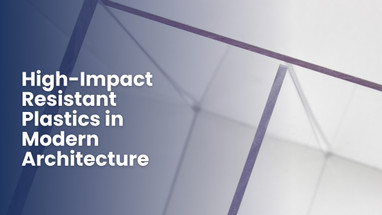Posted by Farco Plastics Supply on 25th Aug 2025
High-Impact Resistant Plastics in Modern Architecture
Introduction
High-impact resistant plastics are advanced materials built to handle heavy force without cracking, shattering, or deforming. In architecture, they are used to improve safety, durability, and design flexibility.
These plastics are showing up in windows, skylights, wall panels, and roofing systems. They allow architects to create bold designs that last, while also saving money on repairs and replacements. At [Company Name], we see them becoming one of the most practical tools in modern building projects.
What Are High-Impact Resistant Plastics?
High-impact resistant plastics are engineered to absorb force and resist damage. They are lighter than glass or metal but tough enough to handle demanding environments.
Common examples include:
- Polycarbonate (PC)
- Acrylic (PMMA)
- High-Density Polyethylene (HDPE)
- Acrylonitrile Butadiene Styrene (ABS)
Each material has unique strengths, making them useful for different parts of a building.
Why They Matter in Architecture
Safety and Durability
Impact-resistant plastics are used in storm-resistant windows, protective wall panels, and skylights. Unlike glass, they don’t shatter into dangerous shards. This makes them safer for public spaces such as schools, stadiums, and airports.
Cost Savings
Because they resist cracking, these plastics last longer than traditional materials. That means fewer replacements and lower maintenance costs. For example, some airports now use polycarbonate partitions because they withstand constant use and wear.
Design Flexibility
These plastics are lightweight and easy to shape. Architects can design curved skylights, translucent roofs, or decorative panels without the weight and fragility of glass. A well-known example is stadium roofing systems built with translucent polycarbonate sheets.
Key Applications
High-impact resistant plastics are versatile. Common uses include:
- Transparent roofing and skylights
- Safety shields and barriers
- Impact-resistant windows
- Durable wall cladding
- Decorative interior panels
At Farco Plastics Supply, we help builders match the right plastic to each project need.
Comparing Popular Plastic Options
Polycarbonate (PC)
Polycarbonate is one of the strongest plastics available. It’s lightweight, resistant to breaking, and can be UV-stabilized for outdoor use. It is often used in skylights, safety shields, and even bulletproof glass.
Acrylic (PMMA)
Acrylic has clarity close to glass but offers more impact resistance. It is scratch-resistant and often chosen for canopies, signage, and decorative panels.
High-Density Polyethylene (HDPE)
HDPE is rugged and moisture-resistant. It performs well in outdoor settings like wall cladding, benches, and protective coverings.
Acrylonitrile Butadiene Styrene (ABS)
ABS is tough and flexible while being cost-efficient. It’s often used in interior applications such as fixtures, partitions, and furniture.
Sustainability and Environmental Factors
Modern architecture requires materials that are both strong and sustainable. Many high-impact resistant plastics can now be recycled or sourced from eco-friendly suppliers.
For example, recycled polycarbonate sheets are used in public buildings to reduce waste. At Farco Plastics, we work with partners who are developing greener options without sacrificing strength or design flexibility.
FAQs
Q: Which plastic is most durable for outdoor structures?
A: Polycarbonate is often the best choice for outdoor use. It resists impact and can be treated to withstand UV exposure.
Q: Can impact-resistant plastics replace glass?
A: Yes. Many architects choose acrylic or polycarbonate because they’re lighter, safer, and easier to shape than glass.
Q: Are these plastics environmentally friendly?
A: Some are recyclable, and new sustainable options are entering the market. At [Company Name], we support eco-conscious sourcing to reduce environmental impact.
Q: What projects use high-impact resistant plastics most?
A: Common projects include stadium roofing, school safety panels, skylights, and transit station partitions.



